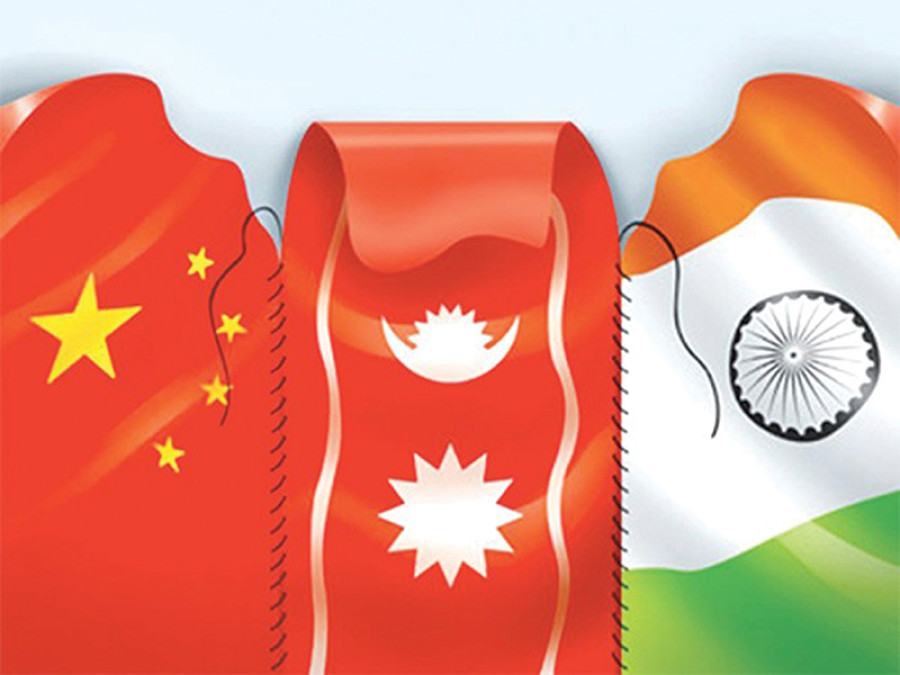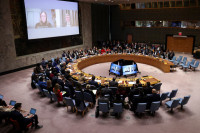Opinion
Stability begins at home
Petty partisan politics over foreign policy for short-term electoral gains will leave the door open for outside interference
Sarin Ghimire
The recent dispute in the Doklam plateau between India and China accentuates the fact that these nuclear-armed nations have set high ambitions of being major superpowers in the region and beyond; and with the aid of a more comprehensive approach on dealing with the geopolitical shift, Nepal is well placed to reap benefits from the two rapidly growing economies. However, without firm commitment on a stable foreign policy, long-term vision on prioritising goals and identification of national interests to align our diplomatic initiatives, Nepal is likely to remain a jostling ground where India and China will vie for influence in the region.
Last month, Nepal faced great pressure to take sides and was eagerly watched by the international community as India and China engaged in a military standoff in the Doklam tri-junction. Sandwiched between two gigantic powers and cajoled by both sides before the eventual agreement between India and China to withdraw troops from the border, Nepal’s geo-strategic importance is undeniable.
Power tussle
The pursuit for Nepal’s support began with Chinese authorities briefing CPN-UML leader KP Oli on their position during his visit to Beijing in July. Reports were also out that Chinese diplomats were engaged in regular talks with their Nepali counterparts over the standoff. Indian foreign minister Sushma Swaraj was said to have passed on New Delhi’s message when she attended the Bimstec ministerial meeting in Kathmandu in August. PM Sher Bahadur Deuba was also given a warm welcome in India the same month, when Indian PM Narendra Modi relayed his desire to make a third trip to Nepal soon. Chinese Vice Premier Wang Yang too dropped by Kathmandu, just when talks were afloat of a possible Sino-Indian war.
Taking into account the geopolitical tensions and repercussions of picking sides, Nepal opted for a non-aligned view in the standoff and chose to withhold comments regarding matters between our two neighbours, and rightly so. However, there were constant questions of whether Nepal would be able to stay neutral, how long this neutrality could be maintained, and under what circumstances.
Revisiting ties
Even as Nepal maintains an equidistant relationship with its two neighbours in theory, the proximity in ties has always differed. Traditionally, Nepal enjoys vast socio-economic and political ties, an open border as well as historic cultural similarities with its southern neighbour, whereas relations with China were primarily driven by Chinese concerns over Tibetan refugees and the one-China policy.
It was not too long ago when Kathmandu elites began exploring the possibility of looking north to explore wider horizons in terms of connectivity and cooperation. Amid growing frustrations over the delayed realisation of promises made by India in terms of development projects, constant border issues, heavy political meddling in Nepal’s internal affairs and a trade embargo that severely punctured our economy, Kathmandu residents began to perceive China as a saviour. Then PM KP Oli signed several bilateral agreements with China, including a transit and transportation treaty and a petro deal. Thus ended Nepal’s total dependency on Indian seaports for third-country trade links and supply of petroleum products. India’s rather disastrous blunder in policy choices forced us to seek alternatives and allowed China to gain a foothold in our internal politics through cautious but calculated moves.
Nepal today foresees tremendous prospects in tourism, rail and road connectivity, and economic activities. Of special note is the One Belt and Road Initiative, China’s new Silk Road plan to connect much of Asia, Africa and Europe. There are also talks emerging of a trans-Himalayan corridor centred in Nepal. On the other hand, Nepal is well aware that India is a more integrated partner owing to a feasible trade route; India is also an immediate potential market for hydropower and industrial or agro products with strong people-to-people relations and cultural ties.
In a globalised world where politics and economics are heavily intertwined, foreign policy choices and outcomes are likely to influence a large electorate, and in many cases could lead to a winning coalition. Over the past decade, both communist parties gained sympathy through elections when they identified themselves as ‘anti-Indian’ establishments. Indians were considered ‘imperialists’ by the then Maoist rebels, and now by the Pushpa Kamal Dahal-led CPN-Maoist Centre. However, despite this stance, Dahal and several other Maoist leaders sought shelter in India during their arms struggle. India also played a vital role in facilitating dialogues to bring the rebels on board for mainstream politics.
Similarly, Oli’s stance against India’s decision to impose the blockade and his nonchalant approach to the sentiments of the Madhesi people proved favourable for the UML, as the party emerged at the top in most local-level elections in the Hilly region and some regions in Madhes as well. Oli managed to use people’s frustration of the blockade to push an ‘anti-India’ rhetoric that more often than not has won over the masses. Oli was also once considered a close confidante of New Delhi.
The palpable sense of instability and differences in foreign policy choices among major political parties raises the question of whether Nepal’s leadership is in a position to derive outcomes by prioritising a national agenda of peace and prosperity. Nepal’s geographical position makes it important for both India and China, and only a balanced approach that revolves around our priorities would prove beneficial for the country. Thus, until major political parties come to an agreement to, at the very least, centre Nepal’s foreign policy in line with aspirations of greater stability for economic development, petty partisan politics will leave the door open for more outside interference.
Ghimire is pursuing an MSc in International Political Economy at the S Rajaratnam School of International Studies, Singapore




 15.69°C Kathmandu
15.69°C Kathmandu












